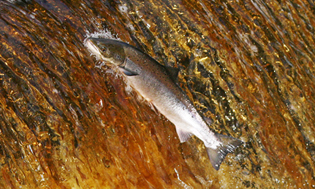 DEFRA has confirmed the Environment Agency’s (EA) Net Limitation Order for drift and T&J nets off the NE coast of England with a finite end point. The draft Order had been published earlier in 2012 and solicited a robust response from fisheries managers throughout the UK, including a number of District Salmon Fishery Boards and the River Tweed Commission, co-ordinated through ASFB.
DEFRA has confirmed the Environment Agency’s (EA) Net Limitation Order for drift and T&J nets off the NE coast of England with a finite end point. The draft Order had been published earlier in 2012 and solicited a robust response from fisheries managers throughout the UK, including a number of District Salmon Fishery Boards and the River Tweed Commission, co-ordinated through ASFB.
The NE net fisheries takes salmon and sea trout that are returning to east coast rivers to spawn. It has long been detrimental to these rivers because it takes fish from many different rivers and indeed from different breeding stocks within these rivers. Some of these stocks are extremely fragile and are near, or below, a safe reproductive level. The NE fishery does not discriminate which fish it takes and so poses a threat to some of these weak stocks. As such it has long been internationally recognised that it is good practice to close these so called “mixed-stock” fisheries and indeed this has been the policy of the British Government.
The Scottish Government closed its own drift net fishery 50 years ago and drift net fisheries have been closed in all other parts of the British Isles since then. In 2004, 52 out of 68 NE drift netsmen agreed to give up their licenses in exchange for fair compensation; 16 chose not to do so despite it being Government policy that the fishery should eventually cease. In releasing this Order, the Government has confirmed that it remains its policy to close the fishery and has now given the drift net fishery an end point of ten years hence and indicated that the only T&J nets that will continue are those that are demonstrated to be exploiting adequate stock levels.
An important change in the new Order is that T&J netsmen will not be able to make a long term transfer their fishing rights to another person upon their death. For now on licenses will be on the same basis as drift nets in that they are time limited to the life of the licensee and for a period of ten years, after which the fishery will close. More licenses (for T&J nets), instead of a maximum number being set for licenses to be issued, will now only be issued to those who have held the same type of license in the previous year. This means that no new applicants may enter the fishery; the number issued cannot be higher than that in the previous season and, over time, the number of licenses available reduces as existing licensees leave the fishery.
DEFRA has also asked the EA to investigate the feasibility of imposing quotas on the fishery within the next ten year period until closure to prevent excess catches being taken.
The Environment Agency is to undertake further research with the aim of evaluating the potential for maintaining some T & J and/or estuary nets. By doing this DEFRA recognises that there may be sustainable T&J fisheries, if these take fish from only one stock, but the research has to demonstrate this so that it conforms with national policy and NASCO guidance on salmonid fishery management.
ASFB welcomes these decisions by DEFRA which recognise good science and established, best fishery management practice at the same time as allowing the fishermen a gradual exit from the fishery.
